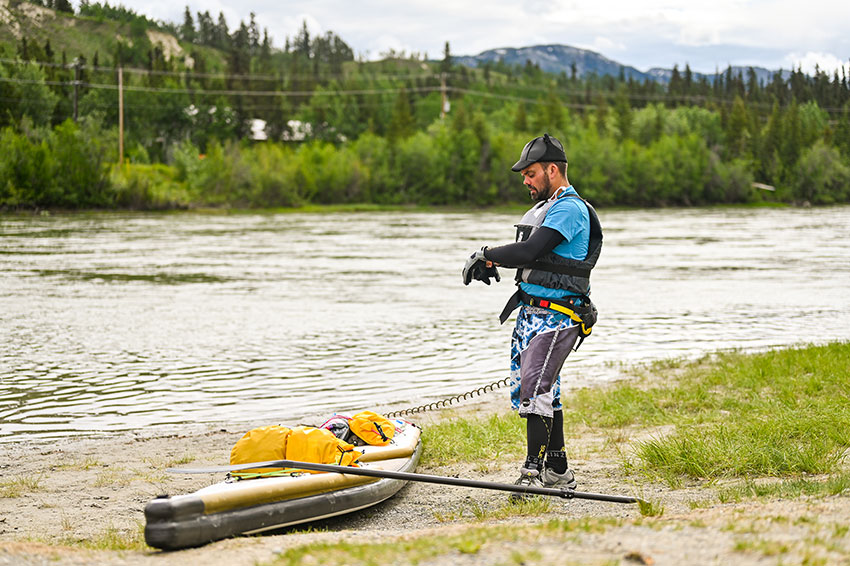Yukon River Quest Story
Text: Thomas Schillig / Photos: @Schaienfotografie
With its 715km, the Yukon River Quest is one of the longest SUP races in the world. Most of this 50- to 60-hour race leads through Canadian wilderness and is hardly accessible by road. Participants must be able to prove that they have sufficient wilderness experience before registering. At 5 to 10 km/h, this river flows rather leisurely and has only one significant rapid. But it is not a leisurely river trip, because if you do not reach the checkpoints in time, you are out of the race. Thomas Schillig, an ultra long distance paddler and Yukon connoisseur, has ventured on this adventure and reports on the fascination of the Yukon River and the motivation for such long distance races.
Preparations

The fact that this race through the Canadian wilderness will not be a normal river trip is already evident from my compulsory equipment. About four days before the start, we go to the equipment check to present the necessary equipment. In addition to spare paddles and a first aid kit, each participant must also carry a satellite pager, tent, sleeping bag, cooker and emergency food for at least 24 hours.
This equipment is extremely important, because in the event of a race cancellation or emergency, it can take several hours for help to arrive, despite the satellite emergency call.
However, it is not planned that these things will ever be needed, because there is simply not enough time for comfortable camping and I would miss the so-called “cut-off” times and be out of the race. For the two mandatory stops in Carmacks and Minto, a personal support team is mandatory. The support team helps me with the ditching, prepares the tent, cooks food and gets everything ready for the onward journey.

Three days before the start of the race I take the time to watch the mandatory stops and the key section Five Finger Rapids and meet the Swiss kayaker Rolf from Thun. Together we analyse the perfect line from the rock. – Too far to the right it pushes against the rock face. Too far to the left there are whirlpools and you risk colliding with driftwood, even whole tree trunks, which flow in from the left. So you have to stay in the middle and head straight for the high wave crests at the end of the rapids. After all, there will be a safety boat at this point during the race.
One day later, another “training run” is scheduled. Well, “training” is perhaps the wrong term here. Anyone who is now on the start list should be sufficiently trained. After all, I had more than 2 years to do that. It’s more about stowing the entire luggage with all the food and drinks on the SUP and carrying out the necessary repacking maneuvres on the river that are needed to replenish the food and water.
The race
At 6 a.m. there is already hustle and bustle on the banks of the Yukon River. SUPs, canoes, kayaks and even 8-person voyager boats are lined up on the shore. The organisers do a final equipment check. – I treat myself to a pasta breakfast in my camper before getting into my dry suit and lining up on the start line in the nearby park.
The starting signal is given punctually at 9am and everyone runs about 500m to their boats on the riverbank. – Yes, running on foot is the order of the day, even though the actual race takes place over 715km on the river, no one misses out on a little sprint.
A convoy of about a hundred boats starts moving. In addition to 17 SUPs, single and double kayaks as well as canoes with up to 8 people start.
At the beginning there is a real crowd, but it soon clears. Three standup paddlers take off with their 24″ wide race hardboards. I don’t rush and first try to find my speed. I gradually overtake a few SUPs and start thinking about how I’m going to master the lake ahead of me. For a week we had top conditions with sun and tailwind, but exactly at the start of the race the weather changes. Rain and headwinds are forecasted, and this can be pretty hefty on the 50km Lake Labarge. Then suddenly an 8-man Voyager overtakes me at a leisurely pace. As it is allowed to draft any boat according to the regulations, I hang on, hoping to save some energy at least until the beginning of the lake. My plan works, and better than expected. I manage to stay on the boat for almost ten hours until the end of the lake. Ten exhausting hours marked by four nasty rain fronts with strong headwinds. But they are also ten entertaining hours, because a fiftieth birthday is being celebrated in the Voyager boat in front of me. Eight paddling ladies in a party mood. – That has a very high entertainment value after all, – and this despite the actual strains!
After about 6 to 8 hours, the muscles in my shoulders and upper arms start to rebel. I know from my training that this pain does not last long and will not have any major late effects.


